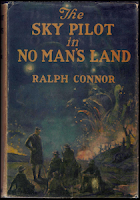The Clue of the Dead Duck
Scott Young
Toronto: Little, Brown, 1962
159 pages
Morgan Perdue and Albert "Young Ab" Magee are up to no good. They've taken advantage of a trip taken by Black Ab – he's Young Ab's dad – to skip school and do a little illegal duck hunting. Friend Sally Connors wanted to join them, but the boys had waved her off. Morgan and Young Ab leave well before dawn, piloting a boat down Irishman's River to the very same floating bog Black Ab uses when hunting duck. No sooner do they arrive than they are attacked and Morgan is knocked out.
The boy regains consciousness to find Young Ab and the boat gone. He spends a long cold day on the bog before being rescued by Sally. She'd grown concerned when the boys hadn't returned. Morgan's rescue sets off a futile search for Young Ab. The Ontario Provincial Police are called in, the RCAF sends a helicopter from CFB Trenton, and yet there is no sign of the missing boy.
There's suspicion from the start. Morgan Perdue is a foster child. He's spent his childhood being shuttled from place to place by Children's Aid. Morgan considers his two years at the Magee house the best he's ever lived, which is something given that the period coincides with Mrs Magee's sudden illness and death. Though no one blames the boy for her passing, Young Ab's Aunt Winnie has always considered Morgan a bad seed. She's certain he's hiding what really happened on Irishman's River:
"Are you sure you and Young Ab didn't didn't have some kind of an argument and then that that [sic] temper of yours didn't get the better of you?"
Detective Sergeant Bower of the OPP has a similar theory. A grim, unfriendly man he isn't so much intent on investigating as obtaining an a confession.
It's this treatment of Morgan, this terrible prejudice, that lends weight to what would otherwise be just another adventure story for children. The boy wants to clear his name, but more than anything he wants to find his friend.
The children of The Clue of the Dead Duck come off so much better than their elders. Sally proves herself a capable, loyal friend. Pearl, Young Ab's little sister comforts Morgan as the adults point fingers. Meanwhile, Morgan somehow manages to find the strength to continue his quest in the face of insinuations and accusations levelled by the adults. His actions, not those of the police, lead to the break in the case and the arrests of the persons responsible for Young Ab's disappearance.
The Clue of the Dead Duck is the sixth book in Little, Brown's Secret Circle series. A strange name, don't you think? It suggests a group of crime solvers, like the Three Investigators, yet the books have no recurring characters. What they do have in common is Arthur Hammond, who not only served as the series' general editor, but provided plot outlines for each title. The subtle social commentary of
The Clue of the Dead Duck sets it apart from Max Braithwaite's
The Mystery of the Muffled Man, the only other Secret Circle book I've read. Whether this is the result of Young's influence or that of Hammond, a man known for his social activism, is a matter of further research. Ultimately, credit goes to the author. Sketching out a story is one thing, writing this is quite another:
The last thing Young Ab said before he went to sleep was that the alarm was set for four o'clock and that we'd better get some sleep.
But sometimes when I'm just about to go to sleep things seem very clear to me. If I've done something wrong during the day, it's in those few minutes before I go to sleep that I worry about it. Now I started thinking, suppose there's an accident? Suppose somebody gets shot? The faces of all the people I knew around Irishman's Lake, all the people who accepted me right now because I was under Black Ab's protection, came up in my mind. But as I lay therein the dark, these faces seemed to be looking at me accusingly. Old ladies had their heads bent together and were looking out of the corners of their eyes at me, and I was scared.
Sadly,
The Clue of the Dead Duck remains relevant. It hasn't aged.

Note: The Clue of the Dead Duck was read for the 1962 Club. Reviews by fellow club members can be found through
this link.
Other books from 1962 reviewed here over the years:
Object: A well-constructed hardcover with series design. The eight illustrations, cover included, are by Douglas Johnson. I purchased my copy last year at Craigy Muir Curiousities in Spencerville, Ontario. Price: $5.00.
Access: Very few copies are listed for sale online – prices range from US$6.00 to US$13.96. Note that not one features the dust jacket.
In 1981,
The Clue of the Dead Duck was reissued as a Seal mass market paperback. As far as I've been able to determine, it was a split run with Scholastic Canada. These editions are being sold by pretend booksellers like Thriftbooks at prices ranging from US$30.42 to $42.48.
Related posts:























































